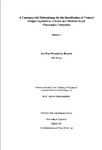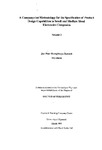A Company-led Methodology for the Specification of Product Design Capabilities in Small and Medium Sized Electronics Companies
| dc.contributor.author | Humphreys Bennett, Jan Paul | |
| dc.contributor.other | Faculty of Science and Engineering | en_US |
| dc.date.accessioned | 2013-10-29T10:13:43Z | |
| dc.date.available | 2013-10-29T10:13:43Z | |
| dc.date.issued | 1995 | |
| dc.identifier | NOT AVAILABLE | en_US |
| dc.identifier.uri | http://hdl.handle.net/10026.1/2427 | |
| dc.description.abstract |
It is the aim of the research reported in this thesis to improve the product design effectiveness of small and medium sized electronics companies in the United Kingdom. It does so by presenting a methodology for use by such firms which will enable them to specify product design capabilities which are resilient to changes in their respective business environments. The research has not, however, concerned itself with the details of particular electronics component technologies or with the advantages of various CAD or CAE products, although these are both important aspects of any design capability. Nor is it concerned with the implementation of the product design capability. The methodology, which represents a significant improvement on current practice, is a structured, company-driven approach which draws extensively upon the lessons of international design best practice. It uses well-proven tools and techniques to guide firms through the entire process of creating such capabilities - from the development of an appropriate Mission Statement to the identification of cost effective and appropriate design system solutions which can readily be translated into action plans for improvement. The work emphasises the importance of adopting a holistic, systems approach which acknowledges the interrelationship between the management of the design process, as well as its operational and supporting activities. The research has been structured around the experiences of companies which have implemented electronics design systems and which "own" the problem in question. Hence, a research strategy was adopted which was based upon a case study approach and upon the development of close collaborative links with two leading design automation tool vendor companies. Case study interviews were undertaken in 18 U.K. and European electronics companies and in 11 U.S., Japanese and Korean electronics firms. The work proceeded in two distinct phases. Firstly, the author participated with other researchers to jointly develop a functional specification of an electronics designers' toolset to support the process of product design in an integrated manufacturing environment. The first phase provided the context for Phase 2, the development of the AGILITY methodology for specifying product design capabilities which represents the author's individual contribution. The contribution to knowledge made by the research lies in the creation of a process methodology which, for the first time, will help U.K. electronics companies to define for themselves product design capabilities which are robust and which support their wider business objectives. No such methodology is currently available in a form which is both accessible and affordable to smaller firms. Furthermore, the author has uncovered no evidence of the existence of such a methodology even for use by large electronics firms. Validation of the methodology is subject to an ongoing process of feedback. | en_US |
| dc.description.sponsorship | Racal Redac Ltd | en_US |
| dc.language.iso | en | en_US |
| dc.publisher | University of Plymouth | en_US |
| dc.title | A Company-led Methodology for the Specification of Product Design Capabilities in Small and Medium Sized Electronics Companies | en_US |
| dc.type | Thesis | |
| plymouth.version | Full version | en_US |
| dc.identifier.doi | http://dx.doi.org/10.24382/4180 |
Files in this item
This item appears in the following Collection(s)
-
01 Research Theses Main Collection
Research Theses Main



